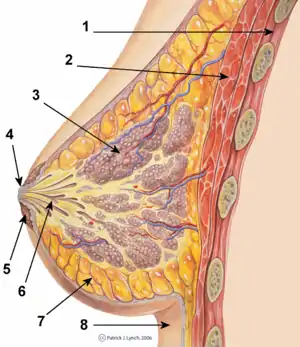Lactiferous duct
Lactiferous ducts are those ducts that converge and form a branched system connecting the nipple to the lobules of the mammary gland. When lactogenesis occurs, under the influence of hormones, the milk is moved to the nipple by the action of smooth muscle contractions along the ductal system to the tip of the nipple. They are also referred to as galactophores, galactophorous ducts, mammary ducts, mamillary ducts or milk ducts.[1][2]
| Lactiferous duct | |
|---|---|
 The Breast: cross-section scheme of the mammary gland. | |
| Details | |
| Identifiers | |
| Latin | ductus lactiferi, tubulus lactiferi |
| TA98 | A16.0.02.010 |
| TA2 | 7103 |
| FMA | 58006 |
| Anatomical terminology | |
Structure
Lactiferous ducts are lined by a columnar epithelium supported by myoepithelial cells. When a woman is not lactating, the lactiferous duct is frequently blocked by a keratin plug. This plug helps to prevent bacteria from entering the duct in non-lactating women. Prior to 2005, it was thought within the areola the lactiferous duct would dilate to form the lactiferous sinus in which milk accumulates between breastfeeding sessions. However past studies have shown that the lactiferous sinus does not exist.[3]
Function
The columnar epithelium plays a key role in balancing milk production, milk stasis and reabsorption. The cells of the columnar epithelium form tight junctions which are regulated by hormones and local factors like pressure and casein content. Prolactin and/or placental lactogen are required for tight junction closure while progesterone is the main hormone preventing closure before birth.[4][5]
Clinical significance
The majority of breast diseases either originate from lactiferous ducts or are closely related. The high susceptibility to benign and malignant diseases is in part a consequence of the cycling hormonal growth stimulation resulting in a high cell turnover and accumulation of defects and complicated hormonal equilibrium which is highly sensible to disturbance.
- most breast cancers arise from the ductal epithelium (see ductal carcinoma in situ)
- phyllodes tumor and intraductal papilloma of the breast
- mastalgia is frequently caused by an imbalance of breast secretion in the lobules and resorption in the ducts
- nonpuerperal mastitis is frequently caused by a similar mechanism in combination with an infection
- duct ectasia is similar and overlapping with the above mentioned
- subareolar abscess and squamous metaplasia of lactiferous ducts
- most forms of fibrocystic breast changes and cysts are thought to originate from lactiferous ducts
Lactiferous Duct Dysmorphia (LDD)
Lactiferous Duct Dysmorphia (LDD) is the deformity or abnormality in the shape or size of a milk duct negatively affecting milk flow (also known as Milk Duct Dysmorphia). Typical causes include: nipple clamps, piercings, or most commonly, ill fitting breast pump flanges.
See also
References
- "galactophore". Retrieved 13 August 2017 – via The Free Dictionary.
- "galactophorous ducts". Retrieved 13 August 2017.
- Ramsay, D. T.; Kent, J. C.; Hartmann, R. A.; Hartmann, P. E. (2005). "Anatomy of the lactating human breast redefined with ultrasound imaging". Journal of Anatomy. 206 (6): 525–534. doi:10.1111/j.1469-7580.2005.00417.x. PMC 1571528. PMID 15960763.
- Nguyen, D. A.; Parlow, A. F.; Neville, M. C. (2001). "Hormonal regulation of tight junction closure in the mouse mammary epithelium during the transition from pregnancy to lactation". The Journal of Endocrinology. 170 (2): 347–356. doi:10.1677/joe.0.1700347. PMID 11479131.
- Nguyen, D. A.; Neville, M. C. (1998). "Tight junction regulation in the mammary gland". Journal of Mammary Gland Biology and Neoplasia. 3 (3): 233–246. doi:10.1023/A:1018707309361. PMID 10819511.